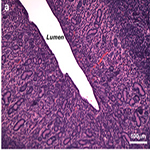Long-term progestin contraceptives (LTPOC) induce aberrant angiogenesis, oxidative stress and apoptosis in the guinea pig uterus: A model for abnormal uterine bleeding in humans
Main Article Content
Abstract
Background
Irregular uterine bleeding is the major side effect of, and cause for, discontinuation of long-term progestin-only contraceptives (LTPOCs). The endometria of LTPOC-treated women display abnormally enlarged, fragile blood vessels (BV), decreased endometrial blood flow and oxidative stress. However, obtaining sufficient, good quality tissues have precluded elucidation of the mechanisms underlying these morphological and functional vascular changes.Methods
The current study assessed the suitability of the guinea pig (GP) as a model for evaluating the uterine effects of LTPOC administration. Thus GPs were treated with a transdermal pellet for 21 days and examined for endometrial histology, angiogenic markers as well as markers of oxidative stress and apoptosis.Results and Discussion
We now demonstrate that GP uteri were enlarged by both estradiol (E2) and medroxyprogesterone acetate (MPA) (p < 0.001). Effects of MPA on uterine weight differed significantly depending on E2 levels (p < 0.001), where MPA opposed the E2 effect in combined treatments. Angiogenesis parameters were similarly impacted upon: MPA alone increased BV density (p = 0.036) and BV average area (p = 0.002). The presence of E2 significantly decreased these parameters. These changes were associated with highly elevated of the lipid peroxidation product, 8-isoprostane (8-isoP) content in E2+MPA-treated and by nuclear 8-OH-deoxyguanosine (8oxoG) staining compared to all other groups (p < 0.001). Abnormalities in the E2+MPA group were consistent with chromatin redistribution, nuclear pyknosis, karyolysis and increased apoptosis as observed by a marked increase in TUNEL labeling.Conclusions
LTPOC exposure alters endometrial vascular and tissue morphology consistent with oxidative stress and apoptosis in a complex interplay with endogenous estrogens. These findings are remarkably similar to in vivochange observed in the human uterus following LTPOC administration. Hence, the GP is an excellent model for the study of LTPOC effects on the uterus and will be extremely useful in determining the mechanistic pathways involved in this process which cannot be conducted on humans.
Article Details
How to Cite
KRIKUN, Graciela et al.
Long-term progestin contraceptives (LTPOC) induce aberrant angiogenesis, oxidative stress and apoptosis in the guinea pig uterus: A model for abnormal uterine bleeding in humans.
Vascular Cell, [S.l.], v. 2, n. 1, p. 8, apr. 2010.
ISSN 2045-824X.
Available at: <https://vascularcell.com/index.php/vc/article/view/10.1186-2040-2384-2-8>. Date accessed: 22 jan. 2026.
doi: http://dx.doi.org/10.1186/2040-2384-2-8.
Section
Original Research

